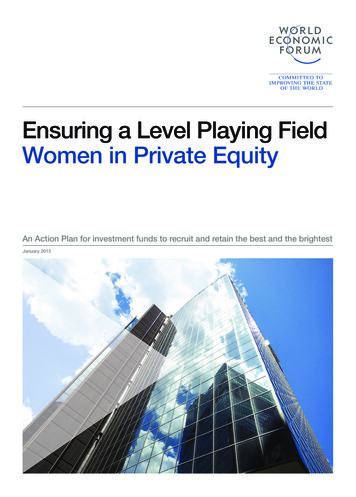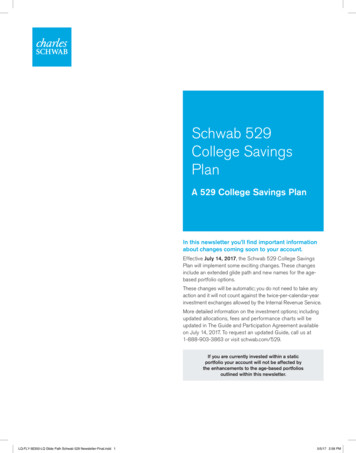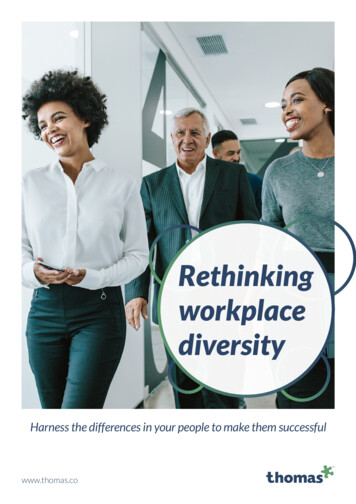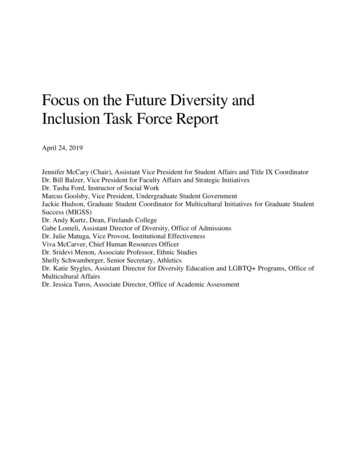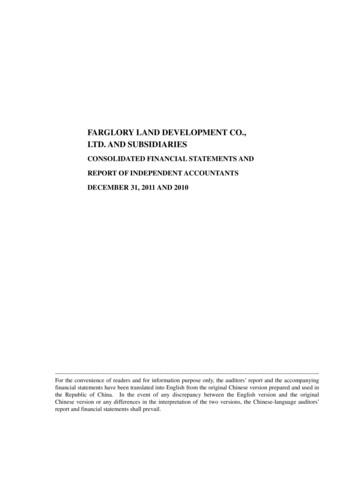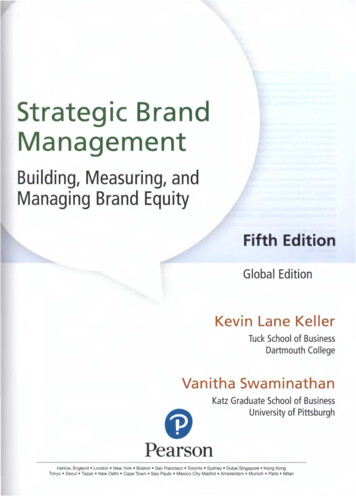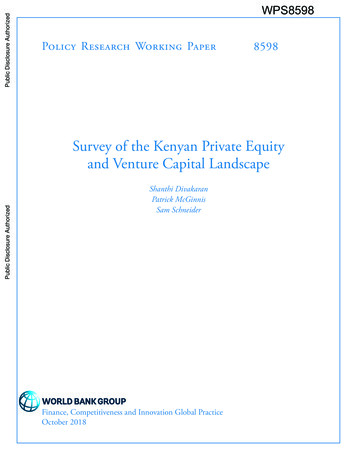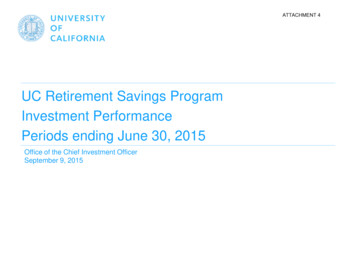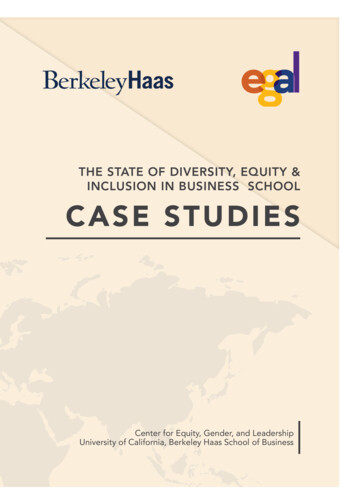
Transcription
THE STATE OF DIVERSITY, EQUITY &INCLUSION IN BUSINESS SCHOOLC AS E S TU D IE SCenter for Equity, Gender, and LeadershipUniversity of California, Berkeley Haas School of Business
Executive SummaryMAY 2020Center for Equity, Gender, and LeadershipUniversity of California, Berkeley Haas School of BusinessThis report was written by Genevieve Smith and Diana Chavez-Varelawith valuable feedback provided by Kellie McElhaney, Jennifer Wells, andLaura Kray from the Center for Equity, Gender, and Leadership (EGAL) atUC Berkeley Haas School of Business. Please reach out to EGAL at egal@berkeley.edu for more information and the full analysis report.2
“Before business school, as part of Management Leadership for Tomorrow and the Consortium for GraduateStudy in Management, I remember how inspired I was bythe few business leaders that shared their success stories that I could identify with. It was powerful to hear aplaybook from someone with a similar lived experience.During business school, as a student, that was non-existent in the classroom. From case studies to guest speakers, not one example that I was able to relate to.”- Rafael Sanchez, Haas MBA, Class of 2019“Growing up as a gay, Chinese, immigrant kid in a predominantly white community, I have gotten used to feeling different than those around me. This difference hasbeen reinforced over time and has affected my ‘sense ofself’. In my first job, I remember looking at all the seniorleaders and realizing that they did not represent the diversity in me. I realized the same thing was happening inbusiness school, where examples of success (for example, the people featured in case studies) were nothinglike me. If we could all look at how we are portrayingsuccessful leaders and feature more diverse examples(which we know are out there), then the next generationof kids who feel different may have one more reason tofeel like they fit in and can be successful.- Alan Man, Haas MBA, Class of 20203
The situationCase studies – using real life business situations or imagined business scenarios – are akey pedagogical tool for instruction withinmanagement education programs. The extentto which case studies are used varies amongschools – Harvard leads the way with an estimated 80% of teaching in its MBA programdelivered through case studies as of 2012.1However, published case studies used in business schools primarily showcase white maleprotagonists2 and often do not incorporatetopics related to diversity, equity and inclusion(DEI) that are critical for businesses leaders tonavigate. While there has been some effortto increase the number of case studies withdiverse protagonists, this does not necessarilytranslate to higher use in classrooms. Professors often repeatedly use the same case studies each semester.The lack of diverse protagonists reinforces astatus quo in which traditional business lead-4ers are primarily both male and white andunintentionally depicts leadership archetypesas traditionally masculine ones. Highlightingonly one model of leadership can signal thatwomen are not suited for leadership and deprives students of alternative role models.3Even when cases have protagonists that arenot white men, case studies often perpetuateharmful stereotypes and gender norms - suchas women being depicted as more emotional,less visionary and less agentic than men.4,5 Inaddition, among cases with female protagonists, credentials as proof of competency werementioned more frequently as opposed tomale leaders,6 and cases with female protagonists tend to be in “pink-collar occupations”. 7Other stereotypes and implicit biases are reinforced in cases related to race, national originand age as well.8
Why it matters & action takenThroughout my MBA, I have read over 500 cases about the businessdilemmas of straight white men How am I supposed to imaginethe world as it could be if I am only allowed to learn from what theworld has always been? Reading a case about a leader who I identifiedwith, would give me confidence and validation - even though I am notnamed John, I have a lived experience worth sharing and a leadershipstyle that can add value to my organization.”- Francesca LeBaron, Haas MBA, Class of 2019There is significant educational value forstudents (undergraduate and graduate)exposed to cases with diverse protagonists and/or on DEI topics. Students whoare exposed to diverse business leadersbenefit from a role model effect; studentswho can relate to diverse leaders enjoybetter self-perceptions and feel moreconfident,9 as well as perform better.10Integrating case studies related to diversity, equity and inclusion can: (1) fostercultural sensitivity among students11;(2) equip students to manage real-lifescenarios in which varying perspectivesand lived experiences are at play; (3)prepare students for increasingly diverseworkplaces where DEI is a strategic advantage; and (4) engage students in critical and timely discussions while offeringthem strategies to promote equity andinclusion throughout the business.Recognizing this gap and importance ofdiversity, equity and inclusion in businessschool education, the Center for Equity,Gender, and Leadership (EGAL) at the UCBerkeley Haas School of Business createda Case Compendium with two sections:(a) case studies with diverse protagonists,and (b) case studies that build “equity fluency” by focusing on DEI-related issuesand opportunities. The compendium, atthe time of this writing, includes 215 cases for diverse protagonists, and 215 cases on DEI-related topics. We will continueto be updated over time.The goal of the compendium is to support professors at Haas, and businessschools globally, to identify cases theycan use, and ultimately, to advancing DEIin education and the business world. Cases were collected from 20 leading publishers using search terms and relying onplatform algorithms to identify cases inorder of relevance and popularity.This brief outlines trends among casestudies collected and gaps, while offeringrecommendations for case study writers /faculty, business schools and case studypublishers. We end with commitmentsfrom EGAL to address existing gaps.5
Our collection and analysis of cases revealed thefollowing findings:Identities of Focus There is a lack of cases with protagonists that are not white men. Of the approximately19,000 cases on Harvard Business Publishing (HBP) Education cases12 (which comprise 80%of cases used in business schools globally), it is difficult to make exact estimates on the diversity of protagonists, but we do find some indications. Approximately 1.3% of cases on HBPappear in searches for “African American” or “Black”. When searching terms there, we found1,826 cases (or 9.45% of total cases) appearing for “woman”, “gender” and “she”. The majority of cases catalogued with diverse protagonists focus on white women. Outof 215 cases, 83.72% portray a protagonist representing gender diversity (largely white, cisfemale protagonists) and 28.84% highlight a protagonist representing race / ethnic diversity(i.e., under-represented minority (URM)). Several cases have a protagonist that is both femaleand a URM (18.60%). The majority of DEI cases catalogued also focus only on gender. The most common identity of focus in DEI-related cases is gender (40.93% of 215 cases) followed by race / ethnicity(20%). Few cases (6.05%) focused on DEI-related issues and opportunities for both race andgender. Many DEI-related cases did not specify particular identity/ies of focus (30.23%). Identities beyond gender (particularly cis female) and/or race / ethnicity are lacking, withsome identities rarely seen. In the DEI-related case studies, only 2.33% include discussionsfocused on diversity of abilities and immigrant / first-generation, and socio-economic diversity. Only 1.40% of the case studies focus on identity/ies related to asylee and refugee diversity.None of the cases include veterans as an identity of focus.83.72% Diverse protagonists graphic 1: 83.72% portray40.93% 6.05%DEI-related topics graphic 1: The most com-a protagonist representing gender diversitymon identity of focus is gender (40.93% of 215(largely white, cis female protagonists).cases).Diverse protagonists graphic 2: 28.84% high- DEI-related topics graphic 2: Few cases (6.05%)light a protagonist representing race / eth-focused on DEI-related issues and opportuni-nic diversity (i.e., under-represented minorityties for both race and gender.(URM)).628.84%
Target SegmentIn the DEI-related cases, most focus on entry and mid-level employees in the Workplace(54.88%) followed by Corporate Board / Leadership (15.35%), Marketplace (10.23%), and thenGeneral Population (7.91%). There is a lack of cases on DEI topics in Supply Chain (1.40%) oramong Investors (0.93%).Disciplines and Topics DEI-related cases are predominantly in Human Resource (HR) Management / Organizational Behavior with a focus on culture and employee representation gaps/ solutions. AmongDEI-related cases, the majority were in HR Management / Organizational Behavior (58.60%),followed by General Management (11.16%). The most common topics are Culture (34.88%)followed by Diverse Employee Representation Gaps / Solutions (21.40%). Cases with diverse protagonists are also mostly in HR Management / Organizational Behavior – particularly if they have female protagonists. HR Management / OrganizationalBehavior is by far the most common discipline (40% of the 215 cases, or 86 cases). Of theseHR / Organizational Behavior cases, the vast majority (90%) have female protagonists. Whilewomen do disproportionately fill HR-related roles as opposed to other technical or P&L positions, this trend perpetuates a harmful, limited narrative based on gendered stereotypes. Thesecond most common discipline is Entrepreneurship (25.58%). Most of the entrepreneurshipcases focus on small-sized businesses and are in social service related industries, as well asretail and finance. Various disciplines are almost non-existent among both case study groups. Each grouplacked cases in the discipline of Leadership (only 1.40% in diverse protagonists cases and1.86% in DEI-related cases). There are also few cases across both case study groups in Supply Chain, Political Economy, Economics, International Business and Negotiation. There weresome in Marketing with 8.37% of diverse protagonist cases in Marketing, and 6.05% amongDEI cases.7
Target SegmentThe top industry among both case study groups is Financial Services (21.40% of DEI-relatedcases, 21.86% of diverse protagonists). The second most common industry among both groups isInformation (14.88% of DEI-related cases, 16.74% of diverse protagonist cases).Perpetuation of StereotypesSeveral case studies reinforce harmful stereotypes and gender norms. This highlights a larger indication of biases of theauthors. We highlight three examples: In “Director’s Dilemma: Balancing Between Quality andDiversity” (2017), the title of the case, as well as the description, implies that more diversity equals less quality,perpetuating the common misguided narrative of diversityin sacrifice of “quality”. In “Carmichael Roberts: To Create a Private Equity Firm?”(2017), the authors described the protagonist as a “rare African-American venture capitalist”. The authors’ selection ofthe word rare could unintentionally commodify the protagonist. In “Organizational Behavior: Management Diversity in theLarge Corporation” (1993), the description says: “How doyou manage talented people that are different from the typical corporate profile like women, blacks, Asians, Hispanicsand others?” The case presents individuals as ‘atypical’ / as‘others’ requiring different management approaches.AuthorsThe majority of the primary authors (first listed) are male. Ofthe DEI-related cases, 55.35% of the primary authors are male,and of the diverse protagonist case studies, 67.91% are male.846.51%Of the DEI-related case studies,the majority that specify a geography occur in the US
GeographyCases are US-centric, although publications from which they were sourced feed cases to business schools globally. For both the diverse protagonist cases and DEI-related cases, the vast majority of cases that specify a geography occur in the US. Among diverse protagonists, the secondmost common country where a geography is specified is Switzerland, but there are very few cases.66.05%Of cases with diverse protagoniststtook place in the United States2.33%Of diverse protagonist cases took place in Switzerland9
Based on the analysis, we outline recommendationsfor case study authors and faculty, business schoolsand case study publishers:For case study authors & faculty1. Explore using cases with diverse protagonists and on DEI topics. Use EGAL’s CaseCompendium to identify cases. We have created a survey tool for any faculty member(at Haas and beyond) to find cases appropriate for their particular context. We reviewthis survey monthly and respond to faculty needs and requests.2. Consider writing and publishing more case studies with diverse protagonists – particularly intersectional identities and for use in courses in the core curriculum.Consider writing and publishing on topics of DEI outside of Human Resource Management / Organizational Behavior-- and particularly across core curriculum courses.3. Ensure case study language used in the case and in the class discussion does notcommodify / discriminate against certain identities, and/or perpetuate stereotypes andharmful norms.4. Engage with centers such as EGAL to write case studies or support research in casestudy development.For business schools1. Encourage and incentivize faculty to utilize case studies with diverse protagonistsor case studies on DEI topics-- assuming the case(s) align with the course and theirteaching goals.2. Support centers such as EGAL to write case studies that fill key gaps, and informfaculty of case study options.3. Educate case study authors / faculty on topics of power, privilege, discrimination,bias and structural inequities and how they can manifest in their classroom discussions.4. Provide faculty and lecturers resources and educational opportunities to integrateDEI in the classroom. A barrier for faculty to use cases with diverse protagonists or onDEI-related topics is a lack of comfort on sensitive topics of diversity. For example, howcan faculty facilitate tough conversations around identity when challenges are broughtup from students?10
For case study publishers1. Review case study applications and descriptions for language that reinforces stereotypes and harmful norms, and challenge the authors toconsider changes.2. Incentivize the writing of new case studies with diverse protagonistsand on DEI topics. In particular, case studies written on DEI-related topicsoutside of the workplace and HR, and sowing diverse protagonists whorepresent intersectionality. For cases with female protagonists, encourage case studies outside of “pink” industries and domains.3.Encourage much greater diversity of case study authors.EGAL’s commitmentEGAL is dedicated to advancing equity fluency among students andbusiness leaders. As part of this mission, based on this analysis and withsupport from the school, EGAL will work to fill critical gaps. In particular: Write case studies with diverse protagonists, particularly those representing intersectional identities and in industries/disciplines outsideof HR and organizational management. Write case studies on DEI-related topics relevant to core courses,particularly where they are missing. As possible, we will prioritize diverse protagonists representing intersectionality. Support faculty in writing / researching new cases (particularly forthe above criteria), as well as in finding relevant cases for use in theirclassrooms. The compendium is meant to fill this gap, as well as thesurvey tool requesting specific support. We will continue to updatethe compendium. Work with the dean’s office and D&I team at Haas to help publicizethis large body of work and valuable set of resources. We offer topartner with the D&I team to provide training for faculty and lecturers to effectively integrate cases in their courses.It is critical the education system responds to the needs of its students and to present-day business needs,as well as to society’s challenges more broadly. We show both a gap and an opportunity for business schoolcase studies as a critical tool for change. Advancing equity fluency among current and future business leadersis critical for sustainable and successful businesses in an increasingly interconnected world.11
The Case Compendium can be found se-studies/case-compendium/Please reach out to EGAL at egal@berkeley.edu formore information and the full analysis report.12
Endnotes1. Byrne, J. (2012). How the world’s top business schools teach their students. Poets & Quants. Retrieved from ds-top-business-schools-teachtheir-mbas/.2. Moules, J. (2018, September 24). MBA Case Studies Lack Female Leaders. Retrieved from -eeb7a9ce36e43. Symons, L., & Ibarra, H. (2014, April 28). What the Scarcity of Women in Business Case StudiesReally Looks Like. Retrieved from -in-businesscase-studies-really-looks-like4. Soule, S. A., Drabkin, D., & Mackenzie, L. (2019, June 24). The Stereotypes in MBA Case Studies.Retrieved from e-studies; Sharen, C. M., & McGowan, R. A. (2018, November 9). Invisible or Clichéd: How Are Women Represented in BusinessCases? - Colleen M. Sharen, Rosemary A. McGowan, 2019. Retrieved from 62918812154?journalCode jmed5. Sharen, C. M., & McGowan, R. A. (2018, November 9). Invisible or Clichéd: How Are WomenRepresented in Business Cases? - Colleen M. Sharen, Rosemary A. McGowan, 2019. Retrieved 052562918812154?journalCode jmed6. Sharen, C. M., & McGowan, R. A. (2018, November 9). Invisible or Clichéd: How Are WomenRepresented in Business Cases? - Colleen M. Sharen, Rosemary A. McGowan, 2019. Retrieved 052562918812154?journalCode jmed7. According to Merriam-Webster, “pink-collar”constitutes “a class of employees in occupations traditionally held by women.” This may include jobs in social work, education, or child care.8. Soule, S. A., Mackenzie, L., & Drabkin, D. (2018, November 9). The Stereotypes in MBA Case Studies. Retrieved from e-studies9. Ammerman, C., Trumbore, A., & Ajayi-Ore, L. (2019, June 24). The Case for Female Protagonists- Harvard Business Publishing Education. Retrieved from for-female-protagonists10. Ammerman, C., Trumbore, A., & Ajayi-Ore, L. (2019, June 24). The Case for Female Protagonists- Harvard Business Publishing Education. Retrieved from for-female-protagonists11. (2018, October 17). Landu, J. Why Cultural Sensitivity Should Be A Forethought Not An Afterthought. Retrieved from ught-not-an-afterthought/#3e6db5fd1b6912. This estimate was identified on May 5, 2020 through the “main case” search function on HarvardBusiness Publishing (https://hbsp.harvard.edu/search?N 4294930433&&Nrpp 25&action refined).13
Center for Equity, Gender, and LeadershipHaas School of BusinessUniversity of California, Berkeley545 Student Services BuildingBerkeley, CA 94720-1900Email: egal@berkeley.edu
Case studies – using real life business situa-tions or imagined business scenarios – are a key pedagogical tool for instruction within management education programs. The extent to which case studies are used




